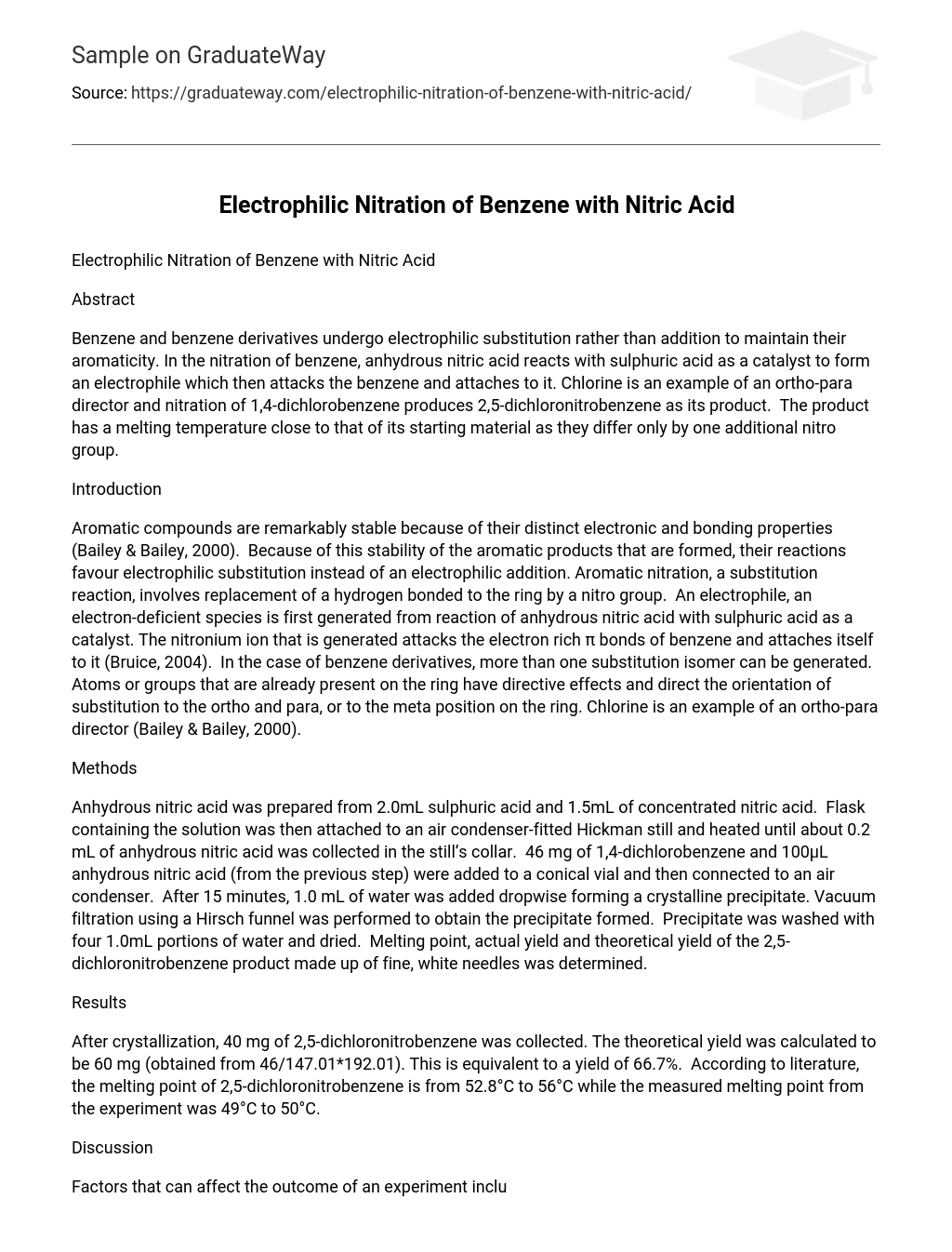Abstract
Benzene and benzene derivatives undergo electrophilic substitution rather than addition to maintain their aromaticity. In the nitration of benzene, anhydrous nitric acid reacts with sulphuric acid as a catalyst to form an electrophile which then attacks the benzene and attaches to it. Chlorine is an example of an ortho-para director and nitration of 1,4-dichlorobenzene produces 2,5-dichloronitrobenzene as its product. The product has a melting temperature close to that of its starting material as they differ only by one additional nitro group.
Introduction
Aromatic compounds are remarkably stable because of their distinct electronic and bonding properties (Bailey & Bailey, 2000). Because of this stability of the aromatic products that are formed, their reactions favour electrophilic substitution instead of an electrophilic addition. Aromatic nitration, a substitution reaction, involves replacement of a hydrogen bonded to the ring by a nitro group. An electrophile, an electron-deficient species is first generated from reaction of anhydrous nitric acid with sulphuric acid as a catalyst. The nitronium ion that is generated attacks the electron rich ? bonds of benzene and attaches itself to it (Bruice, 2004). In the case of benzene derivatives, more than one substitution isomer can be generated. Atoms or groups that are already present on the ring have directive effects and direct the orientation of substitution to the ortho and para, or to the meta position on the ring. Chlorine is an example of an ortho-para director (Bailey & Bailey, 2000).
Methods
Anhydrous nitric acid was prepared from 2.0mL sulphuric acid and 1.5mL of concentrated nitric acid. Flask containing the solution was then attached to an air condenser-fitted Hickman still and heated until about 0.2 mL of anhydrous nitric acid was collected in the still’s collar. 46 mg of 1,4-dichlorobenzene and 100?L anhydrous nitric acid (from the previous step) were added to a conical vial and then connected to an air condenser. After 15 minutes, 1.0 mL of water was added dropwise forming a crystalline precipitate. Vacuum filtration using a Hirsch funnel was performed to obtain the precipitate formed. Precipitate was washed with four 1.0mL portions of water and dried. Melting point, actual yield and theoretical yield of the 2,5-dichloronitrobenzene product made up of fine, white needles was determined.
Results
After crystallization, 40 mg of 2,5-dichloronitrobenzene was collected. The theoretical yield was calculated to be 60 mg (obtained from 46/147.01*192.01). This is equivalent to a yield of 66.7%. According to literature, the melting point of 2,5-dichloronitrobenzene is from 52.8°C to 56°C while the measured melting point from the experiment was 49°C to 50°C.
Discussion
Factors that can affect the outcome of an experiment include human and instrument errors in measurement and performance that would lead to a measured yield that is less than the theoretical value. A known amount of 1,4-dichlorobenzene would react with a specific volume of anhydrous nitric acid. Since 46 mg 1,4-dichlorobenzene was used instead of 38, this probably requires more volume of anhydrous nitric acid. The reaction time of 15 minutes may not be enough to achieve completion of the reaction as there are increased amounts of reactants. Some amount of product of the reaction may have been lost in the washing procedures and while transferring to a different filter paper. The slight difference between the theoretical and actual values for the melting temperature may be attributed to contaminants. This could either come from the glassware used or the solutions such as water that was used to wash the product.
Conclusion
Synthesis of aromatic derivatives of benzene involves an understanding of the properties of benzene and the mechanism by which its reactions proceed. Directive effect of groups attached to benzene derivatives is one important property that should be considered in electrophilic substitution reactions. The benzene derivatives 1,4-dichlorobenzene and 2,5-dinitrochlorobenzene have melting temperatures close to each other since their molecular weights differ by only 45.
References
Bailey, P. S., & Bailey, C. (2000). Organic Chemistry : A Brief Survey of Concepts and
Applications. Upper Saddle River, New Jersey 07458: Prentice Hall.
Bruice, P. Y. (2004). Organic Chemistry. Upper Saddle River, NJ 07458: Prentice Hall.





